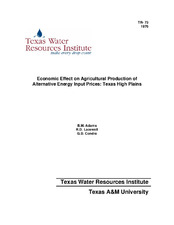| dc.description.abstract | The Arab oil embargo of 1973 awakened the world to the reality of energy shortages and higher fuel prices. Agriculture in the United States is highly mechanized and thus energy intensive. This study seeks to develop an evaluative capability to readily determine the short-run effect of rising energy prices on agricultural production. The results are measured in terms of demand schedules for each input investigated, net revenue adjustments, cropping pattern shifts, and changes in agricultural output.
The High Plains of Texas was selected as a study area due to the heterogeneous nature of agricultural production in the region and highly energy intensive methods of production employed. The region is associated with a diversity in crops and production practices as well as a high degree of mechanization and irrigation, which means agriculture is very dependent upon energy inputs and, in turn, is significantly affected by energy price changes. The study area was defined by the Texas Agricultural Extension subregions of High Plains II, High Plains III, and High Plains IV. The crops chosen for study were cotton, grain sorghum, wheat, corn, and soybeans. The energy and energy-related inputs under investigation were diesel, herbicide, natural gas, nitrogen fertilizer, and water.
Mathematical linear programming was used as the analytical technique with parametric programming techniques incorporated into the LP model to evaluate effect of varying input price parameters over a specified range. Thus, demand schedules were estimated. The objective function was constructed using variable costs only; no fixed costs are considered. Therefore, the objective function maximizes net revenue above variable costs and thus limits the study to the short run.
The data bases for the model were crop enterprise budgets developed by the Texas Agricultural Extension Service. These budgets were modified to adapt them to the study. Particularly important was the substitution of owner-operated harvesting equipment for custom-harvesting costs. This procedure made possible the delineation of fuel use by crop and production alternative which was necessary information in the accounting of costs. The completed LP model was applied to 16 alternative situations made up of various input and product price combinations which are considered as feasible in the short run future.
The results reveal that diesel consumption would change very little in the short run unless commodity prices simultaneously decline below the lowest prices since 1971 or unless diesel price approaches $2.00 per gallon. Under average commodity price conditions, natural gas consumption would not decline appreciably until the price rose above $4.00 per 1000 cubic feet (mcf). Even when using the least product prices since 1971, natural gas would be consumed in substantial amounts as long as the price was below $1.28 per Mcf. The findings regarding nitrogen indicate that present nitrogen prices are within a critical range such that consumption would be immediately affected by nitrogen price increases.
Water price was considered as the price a farmer can afford to pay for water above pumping and distribution costs. Application of water was defined as the price that would be paid for imported water. Under average commodity price conditions, the study results show that as water price rises from zero dollars to $22 per acre foot there would be less than a 4 percent reduction in consumption. However, as the price continues to rise, consumption would decline dramatically reaching zero at a water price of $71.75 per acre foot.
This study indicates that rising input prices would cause acreage shifts from irrigated to dryland; however, with average commodity prices, these shifts do not occur until diesel reaches $2.69 per gallon, or natural gas sells for $1.92 per Mcf, or nitrogen price is $.41 per pound, or water price reaches $14.69 per acre foot. In general, the first crops that would shift out of production as energy input prices rise would be grain sorghum and corn. Cotton does not appear to be significantly affected by feasible near future energy price rises; while wheat was found to increase in production as fuel costs increase.
Whereas rising energy prices mildly affect consumption of inputs, cropping shifts, and output, they significantly impact on net revenue to the farmer. With average product prices, the results indicate that farmers' net income above variable cost approach $500 million at present diesel prices ($.40 per gallon). A doubling of diesel price to $.81 per gallon would cost the farmer $79 million in net revenue, and a price rise to $1.86 per gallon would cost $254 million in farmer net revenue. The results of natural gas, nitrogen, and water are similar to diesel in that the increased cost of the input directly reduces net revenue.
Throughout the analysis, commodity prices were shown to be more consequential to agricultural production and farmer welfare than are energy input prices. A synoptic statement of the findings is as follows: in the short run future assuming average prices for commodities, farmers in the Texas High Plains will continue to produce at present levels according to established cropping patterns unless diesel reaches a $2.00 per gallon price range, or natural gas price approaches $4.00 per Mcf, or nitrogen sells for around $.40 per pound. Furthermore, the importation of water is feasible only if its cost can be kept well below $70 per acre foot. | en |


